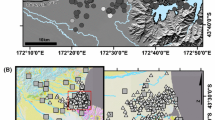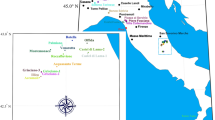Abstract
This paper presents empirical correlations between amplification factors and simple site parameters derived from a large subset of the KiK-net data. The amplification factor is estimated from the ratios between the surface and down-hole horizontal response spectra, corrected for the varying depths and impedance of the down-hole sites (Cadet et al. in Site effect assessment using KiK-net data—part 1—a simple correction procedure for surface/downhole spectral ratios, 2011). Several site parameters are selected on the basis of their simplicity and availability at relatively low cost. They are the shallow time-average velocities VSZ, with z equal to 5, 10, 20 and 30 m, and the fundamental frequency f0. The amplification factors are then correlated with each of the individual site parameters; four other “twin-parameter”—couples (f0, VSZ)—are also considered and the correlation with amplification factors is performed through a normalization of the frequencies by each site fundamental frequency. The quality of the correlations is given by a misfit compared with the original data variance. The largest variance reduction is obtained with twin-parameter characterizations, out of which the couple (f0, VS30) proves to provide the lower misfit. The performance of single parameter correlations is relatively lower; however, the best single parameter proves to be the fundamental frequency, which provides smaller misfit than the Vsz parameters. A comparison is also performed with the amplification factors recommended in European regulations, showing that it is possible right now to significantly improve both the site characterization criteria and the associated amplification factors, for use in building codes and microzonation studies.
Similar content being viewed by others
References
Abrahamson NA, Silva WJ (2008) Summary of the Abrahamson & Silva NGA ground-motion relations. Earthq Spectra 24(1): 67–97
Assimaki D, Li W, Steidl JH, Tsuda K (2008) Site amplification and attenuation via downhole array seismogram inversion: a comparative study of the 2003 Miyagi-Oki, aftershock sequence. Bull Seism Soc Am 98(1): 301–330. doi:10.1785/0120070030
Asten MW, Boore DM (2005) Comparison of shear-velocity profiles of unconsolidated sediments near the Coyote borehole (CCOC) measured with fourteen invasive and non-invasive methods, Blind comparisons of shear-wave velocities at closely-spaced sites in San Jose, California. US Geological Survey. Open-File Report 2005-1169, part 1. [http://pubs.usgs.gov/of/2005/1169/]
Asten MW, Dhu T, Lam N (2004) Optimised array design for microtremor array studies applied to site classification; observations, results and future use. In: Proceedings of the 13th world conference of earthquake engineering, Vancouver, August 2004
Bard P-Y, Bouchon M (1980a) The seismic response of sediment-filled valleys. Part 1: the case of incident SH waves. Bull Seism Soc Am 70: 1263–1286
Bard P-Y, Bouchon M (1980b) The seismic response of sediment-filled valleys Part 2: the case of incident P and SV waves. Bull Seism Soc Am 70: 1921–1941
Bard P-Y, SESAME participants (2004) The SESAME project: an overview and main results. In: Proceedings of the 13th world conference in earthquake engineering, Vancouver, August 2004, Paper # 2207
Bard P-Y, Cadet H, Endrun B, Hobiger M, Renalier F et al (2010) From non-invasive site characterization to site amplification: recent advances in the use of ambient vibration measurements. In: Garevski M (ed) Earthquake engineering in Europe, geotechnical, geological, and earthquake engineering, vol 17. doi:10.1007/978-90-481-9544-2_5. Springer Science+Business Media B.V. 2010
Bazzurro P (1998) Probabilistic seismic demand analysis. PhD Thesis, supervised by C.A. Cornell, Stanford University, Palo Alto, CA
Bazzurro P, Cornell CA, Pelli F (1999) Site- and Soil-specific PSHA for Nonlinear Soil Sites. In: Proceedings of 2nd international symposium on earthquake resistant engineering structures. ERES99, 15–17 June, Catania, Italy
Beauval C, Bard P-Y, Moczo P, Kristek J (2003) Quantification of frequency-dependent lengthening of seismic ground motion duration due to local geology: applications to the Volvi area (Greece). Bull Seism Soc Am 93(1): 371–385
Boore DM (2003) Simulation of ground motion using stochastic method. Pure Appl Geophys 160: 635–676
Borcherdt RD (1994) Estimates of site-dependent response spectra for design (methodology and justification). Earthq Spectra 10: 617–653
Cadet H (2007) Utilisation combinée des méthodes basées sur le bruit de fond dans le cadre du microzonage sismique. Thèse de doctorat de l’Université Joseph Fourier, Grenoble, Octobre 2007
Cadet H, Bard P-Y, Rodriguez-Marek A (2010) Defining a standard rock. Propositions based on the KiK-net data. Bull Seism Soc Am 100: 172–195. doi:10.1785/0120090078
Cadet H, Bard P-Y, Rodriguez-Marek A (Nov, 2011) Site effect assessment using KiK-net data—part 1—a simple correction procedure for surface / downhole spectral ratios (submitted to BEE)
Cadet H, Duval A-M (May/June, 2009) A shear wave velocity study based on the KiK-net borehole data. Seism Res Lett 80(3)
Castellaro S, Mulargia F, Rossi PM (2008) Vs30: Proxy for seismic amplification?. Seism Res Lett 79(4): 540–543
Chatelain J-L, Guillier B, Cara F, Duval A-M, Atakan K, Bard P-Y, Azzara R et al (2008) Evaluation of the influence of experimental conditions on H/V results from ambient noise recordings. Bull Earthq Eng 6(1): 33–74
Chiou BS-J, Youngs RR (2008) An NGA model for the average horizontal component of peak ground motion and response spectra. Earthq Spectra 24(1): 173–215
Cotton F, Pousse G, Bonilla LF, Scherbaum F (2008) On the discrepancy of recent European ground motion observation and predictions from empirical models. Analysis of KIK-net accelerometric data and point source stochastic simulations. Bull Seism Soc Am 98(5): 2244–2261
Cornou C, Bard P-Y (2003) Site-to-bedrock over 1D transfer function ratio: an indicator of the proportion of edge-generated surface waves? Geophys Res Lett 30-9
Cornou C, Ohrnberger M, Boore D, Kudo K, Bard P-Y (2008) Derivation of structural models from ambient vibration array recordings: results from an international blind test. ESG2006, vol 2
Eurocode 8 (1998) Design of structures for earthquake resistance, part 1: general rules, seismic actions and rules for buildings, EN 1998-1. European Committee for Standardization (CEN). http://www.cen.eu/cenorm/homepage.htm
Guillier B, Atakan K, Chatelain J-L, Havskov J, Ohrnberger M, Cara F, Duval A-M, Zacharopoulos S et al (2008) Influence of instruments on the H/V spectral ratios of ambient vibrations. Bull Earthq Eng, 2008-1
Goda K, Atkinson GM (2009) Probabilistic characterization of spatially correlated response spectra for earthquakes in Japan. Bul Seism Soc Am 99(5): 3003–3020
Haghshenas E, Bard P-Y, Theodulidis SESAME WP04 Team (2008) Empirical evaluation of microtremor H/V spectral ratio. Bull Earthq Eng 6(1): 75–108
Konno K, Ohmachi T (1998) Ground-motion characteristics estimated from spectral ratio between horizontal and vertical components of microtremor. Bull Seism Soc Am 88(1): 228–241
Kokusho T, Sato K (2008) Surface-to-base amplification evaluated from KiK-net vertical array strong motion records. Soil Dyn Earthq Eng 28(9): 707–716. doi:10.1016/j.soildyn.2007.10.016
Lee VW, Trifunac MD (2010) Should average shear-wave velocity in the top 30 m of soil be used to describe seismic amplification?. Soil Dyn Earthq Eng 30(11): 1250–1258. doi:10.1016/j.soildyn.2010.05.007
Lermo J, Chavez-Garcia FJ (1993) Site effect evaluation using spectral ratios with only one station. Bull Seism Soc Am 83(5): 1574–1594
Moss R (2008) Quantifying measurement uncertainty of thirty-meter shear-wave velocity. Bull Seism Soc Am 98(3): 1399–1411. doi:10.1785/0120070101
Mucciarelli M, Gallipoli MR (2006) Comparison between Vs30 and other estimates of site amplification in Italy. In: Proceedings 1st European conference on earthquake engineering and seismology, Cd-Rom edition, paper 270
Nakamura Y (1989) A method for dynamic characteristics estimation of subsurface using microtremor on the ground surface. Q Rep Railw Tech Res Inst 30(1): 25–30
NEHRP (2001) Building Seismic Safety Council (BSSC). National earthquake hazards, reduction program (NEHRP) Recommended provisions for seismic regulations for new buildings and other Structures, part 1—provisions and part 2—commentary. Reports No. FEMA-368 and FEMA-369, prepared by the Building Seismic Safety Council for the Federal Emergency Management Agency, Washington, DC
Ohrnberger M (2005) Report on the FK/SPAC capabilities and limitations. SESAME Deliverable D19.06. http://sesame-fp5.obs.ujf-grenoble.fr/Delivrables/Del-D19-Wp06.pdf
Ohrnberger M, Schissele E, Cornou C, Bonnefoy-Claudet S, Wathelet M, Savvaidis A, Scherbaum F, Jongmans D (2004) Frequency wavenumber and spatial autocorrelation methods for dispersion curve determination from ambient vibration recordings. Paper No. 0946, 13th world conference on earthquake engineering, Vancouver, BC, Canada
Oth A, Parolai S, Bindi D (2011a) Spectral analysis of K-NET and KiK-net data in Japan, part I: database compilation and peculiarities. Bull Seism Soc Am 101(2): 652–666. doi:10.1785/0120100134
Oth A, Bindi D, Parolai S, Di Giacomo D (2011b) Spectral analysis of K-NET and KiK-net data in Japan, part II: on attenuation characteristics, source spectra, and site response of borehole and surface stations. Bull Seism Soc Am 101(2): 667–687. doi:10.1785/0120100135
Pousse G, Berge-Thierry C, Bonilla F, Bard P-Y (2005) Eurocode 8 design response spectra evaluation using the K-Net Japanese database. J Earthq Eng 9(4): 547–574
Power M, Chiou B, Abrahamson N, Bozorgnia Y, Shantz T, Roblee C (2008) An overview of the NGA project. Earthq Spectra 24(1): 3–21. doi:10.1193/1.2894833
Renalier F (4 Mar, 2010) Caractérisation sismique de sites hétérogènes à partir de méthodes actives et passives : variations latérales et temporelles. Ph.D. thesis, University Joseph Fourier, Grenoble
Renalier F, Endrun B, Alkan MA et al (2009) Comparative analysis of classical measurements and newly developed methods. Delivrable D6, 41 pp + 2 Appendix, NERIES project. http://www.neries-eu.org
SESAME project. http://SESAME-FP5.obs.ujf-grenoble.fr
Vucetic M, Dobry R (1991) Effect of soil plasticity on cyclic response. ASC J Geotech Eng 117(1): 89–109
Walling M, Silva W, Abrahamson NA (2008) Nonlinear site amplification factors for constraining the NGA models. Earthq Spectra 24: 243–255
Wathelet M, Jongmans D, Ohrnberger M (2004) Surface wave inversion using a direct search algorithm and its application to ambient vibration measurements. Near Surf Geophys 2: 211–221
Wathelet M, Jongmans D, Ohrnberger M (2005) Direct inversion of spatial autocorrelation curves with the neighborhood algorithm. Bull Seism Soc Am 95: 1787–1800
Zaré M, Bard P-Y, Ghafory-Ashtiany M (1999) Site categorization for the Iranian strong motion network. Soil Dyn Earthq Eng 18: 101–123
Zhao JX (2006) An empirical site classification method for strong motion station in Japan using H/V response spectral ratio. Bull Seism Soc Am 96(3): 914–925
Author information
Authors and Affiliations
Corresponding author
Additional information
An erratum to this article can be found at http://dx.doi.org/10.1007/s10518-011-9324-9.
Rights and permissions
About this article
Cite this article
Héloïse, C., Bard, PY., Duval, AM. et al. Site effect assessment using KiK-net data: part 2—site amplification prediction equation based on f0 and Vsz. Bull Earthquake Eng 10, 451–489 (2012). https://doi.org/10.1007/s10518-011-9298-7
Received:
Accepted:
Published:
Issue Date:
DOI: https://doi.org/10.1007/s10518-011-9298-7




